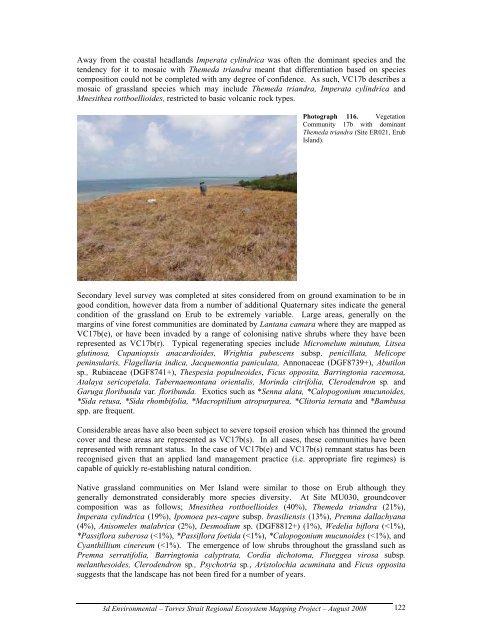Appendix 2 - Vegetation Communities and Regional Ecosystems
Appendix 2 - Vegetation Communities and Regional Ecosystems
Appendix 2 - Vegetation Communities and Regional Ecosystems
Create successful ePaper yourself
Turn your PDF publications into a flip-book with our unique Google optimized e-Paper software.
Away from the coastal headl<strong>and</strong>s Imperata cylindrica was often the dominant species <strong>and</strong> the<br />
tendency for it to mosaic with Themeda tri<strong>and</strong>ra meant that differentiation based on species<br />
composition could not be completed with any degree of confidence. As such, VC17b describes a<br />
mosaic of grassl<strong>and</strong> species which may include Themeda tri<strong>and</strong>ra, Imperata cylindrica <strong>and</strong><br />
Mnesithea rottboellioides, restricted to basic volcanic rock types.<br />
Photograph 116. <strong>Vegetation</strong><br />
Community 17b with dominant<br />
Themeda tri<strong>and</strong>ra (Site ER021, Erub<br />
Isl<strong>and</strong>).<br />
Secondary level survey was completed at sites considered from on ground examination to be in<br />
good condition, however data from a number of additional Quaternary sites indicate the general<br />
condition of the grassl<strong>and</strong> on Erub to be extremely variable. Large areas, generally on the<br />
margins of vine forest communities are dominated by Lantana camara where they are mapped as<br />
VC17b(e), or have been invaded by a range of colonising native shrubs where they have been<br />
represented as VC17b(r). Typical regenerating species include Micromelum minutum, Litsea<br />
glutinosa, Cupaniopsis anacardioides, Wrightia pubescens subsp. penicillata, Melicope<br />
peninsularis, Flagellaria indica, Jacquemontia paniculata, Annonaceae (DGF8739+), Abutilon<br />
sp., Rubiaceae (DGF8741+), Thespesia populneoides, Ficus opposita, Barringtonia racemosa,<br />
Atalaya sericopetala, Tabernaemontana orientalis, Morinda citrifolia, Clerodendron sp. <strong>and</strong><br />
Garuga floribunda var. floribunda. Exotics such as *Senna alata, *Calopogonium mucunoides,<br />
*Sida retusa, *Sida rhombifolia, *Macroptilium atropurpurea, *Clitoria ternata <strong>and</strong> *Bambusa<br />
spp. are frequent.<br />
Considerable areas have also been subject to severe topsoil erosion which has thinned the ground<br />
cover <strong>and</strong> these areas are represented as VC17b(s). In all cases, these communities have been<br />
represented with remnant status. In the case of VC17b(e) <strong>and</strong> VC17b(s) remnant status has been<br />
recognised given that an applied l<strong>and</strong> management practice (i.e. appropriate fire regimes) is<br />
capable of quickly re-establishing natural condition.<br />
Native grassl<strong>and</strong> communities on Mer Isl<strong>and</strong> were similar to those on Erub although they<br />
generally demonstrated considerably more species diversity. At Site MU030, groundcover<br />
composition was as follows; Mnesithea rottboellioides (40%), Themeda tri<strong>and</strong>ra (21%),<br />
Imperata cylindrica (19%), Ipomoea pes-capre subsp. brasiliensis (13%), Premna dallachyana<br />
(4%), Anisomeles malabrica (2%), Desmodium sp. (DGF8812+) (1%), Wedelia biflora (


